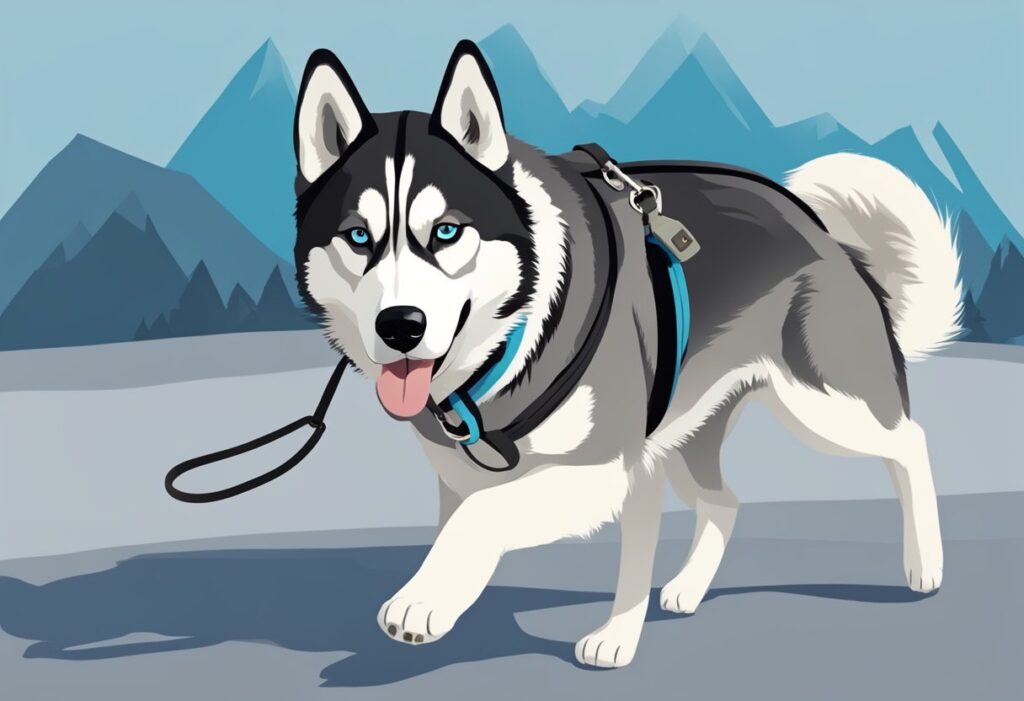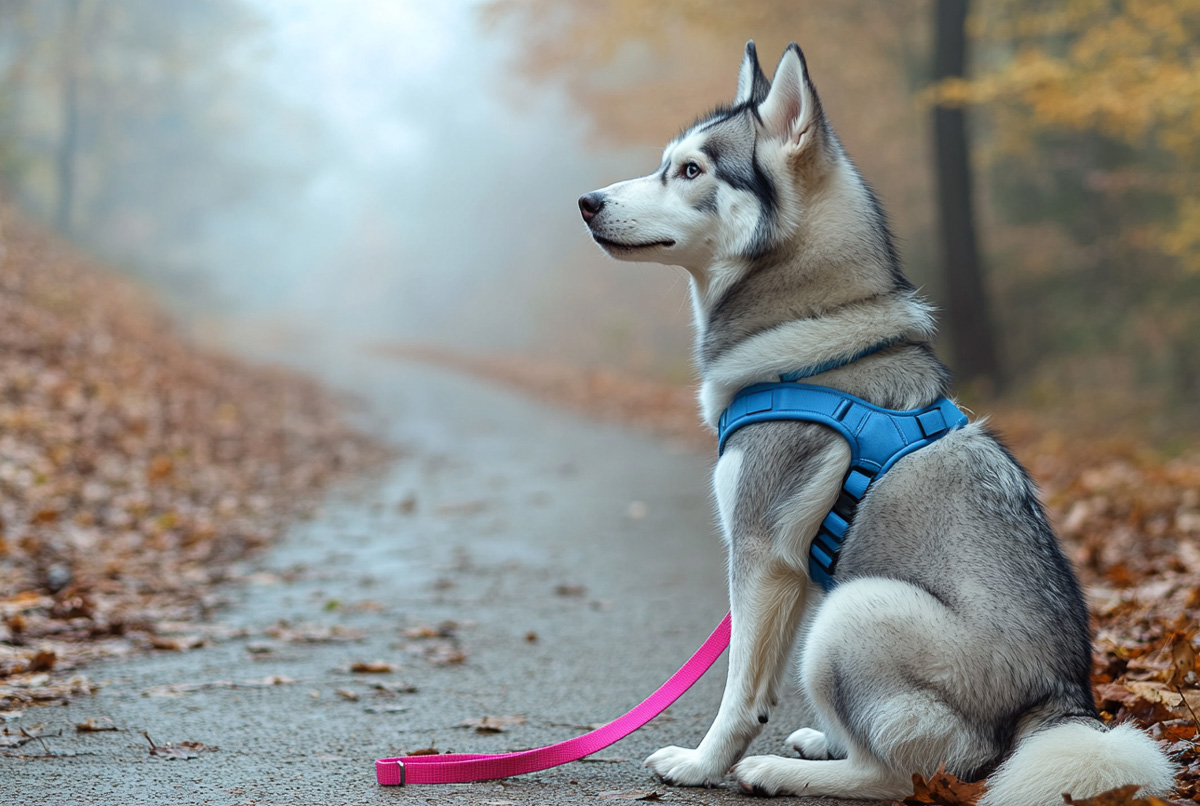Huskies are known for their strong-willed nature and independent spirit. These beautiful dogs can be a joy to own, but their stubborn streak can test even the most patient owners. Many husky parents find themselves scratching their heads, wondering how to get their furry friend to listen.

Training a stubborn husky takes time, consistency, and the right approach. It’s key to understand that huskies were bred to work in teams, pulling sleds over long distances. This background shapes their behavior and explains why they may not always follow commands like other breeds.
Dealing with a stubborn husky isn’t about dominating the dog. It’s about building a strong bond and finding ways to motivate them.
Positive reinforcement, mental stimulation, and plenty of exercise are crucial. With the right methods, even the most headstrong husky can become a well-behaved companion.
Key Takeaways
- Huskies need consistent training tailored to their unique traits
- Positive reinforcement and mental stimulation are key to success
- Regular exercise helps manage a husky’s energy and reduces stubbornness
Understanding Husky Temperament
Huskies have a unique temperament that stems from their history as sled dogs. They are known for their independent nature and strong-willed personality.
Husky Character Traits
Huskies are intelligent, energetic, and social dogs. They love to be part of a pack and thrive on human companionship. These dogs have a strong prey drive and may chase small animals.
Huskies are often described as:
- Friendly
- Outgoing
- Mischievous
- Stubborn
They have high energy levels and need plenty of exercise. Without proper outlets, they may become destructive or escape artists.
Huskies are not typically aggressive but can be protective of their family. They tend to be vocal, using howls and “talking” to communicate.
Origin of Stubborn Behaviors
Huskies were bred to work in harsh conditions and make quick decisions. This background contributes to their stubborn nature.
Some reasons for husky stubbornness include:
- Independent thinking: Huskies were trained to problem-solve on their own.
- Selective hearing: They may ignore commands that don’t interest them.
- Boredom: Without mental and physical stimulation, they become willful.
Their strong-willed nature can make training challenging. Huskies respond best to positive reinforcement and consistent rules. They need a confident owner who can provide firm, but gentle guidance.
Regular exercise and mental stimulation help reduce stubborn behaviors. Puzzle toys and obedience training can keep their minds engaged.
Fundamentals of Husky Training
Huskies need clear leadership and consistent training to thrive. Proper techniques help shape their behavior and build a strong bond with their owner.
Establishing Leadership
Huskies respond best to calm, confident leaders. Set clear rules and stick to them. Use a firm but gentle tone when giving commands. Reward good behavior with treats or praise. Ignore bad behavior instead of punishing.
Take charge during walks by leading the way. Make the husky sit before meals and wait for permission to eat. These small acts show you’re in control. Be patient – it takes time for huskies to accept leadership.
Training Techniques
Start training early and keep sessions short. Use positive reinforcement like treats and toys. Clicker training works well for huskies. Break tasks into small steps. Practice commands daily in different places.
Focus on basic obedience like sit, stay, and come. Teach leash manners to stop pulling. Use games to make training fun. Puzzle toys challenge their minds. Huskies need mental and physical exercise.
Don’t give up if progress is slow. Stay calm and consistent. Seek help from a pro trainer if needed. With time and effort, even stubborn huskies can learn good habits.
Behavioral Modification Strategies
Training a stubborn husky requires patience and the right approach. Effective techniques focus on positive reinforcement and staying consistent over time.
Discipline and Positive Reinforcement
Huskies respond best to positive reinforcement. Reward good behavior with treats, praise, or toys. This encourages them to repeat desired actions.
Avoid harsh punishments. They can damage the bond with your husky and increase stubbornness. Instead, redirect unwanted behaviors to appropriate activities.
Use a firm but calm voice for commands. Huskies pick up on tone and energy. Stay confident and in control.
Time-outs can work for overexcited huskies. Put them in a quiet space for a few minutes to calm down.
Consistency in Training
Set clear rules and stick to them. All family members should use the same commands and rewards.
Train in short sessions multiple times a day. Huskies have short attention spans. Keep it fun and engaging.
Be patient. Huskies are intelligent but independent. It may take time for new behaviors to stick.
Use the same cues each time. For example, always say “sit” instead of mixing in “sit down.”
Practice commands in different locations. This helps the husky understand to listen everywhere, not just at home.
Overcoming Training Challenges
Training a stubborn husky takes patience and the right approach. Huskies can be resistant to commands, but with consistent effort and positive reinforcement, you can achieve success.
Dealing with Resistance
Huskies are known for their independent nature. They may ignore commands or seem uninterested in training. To overcome this, use high-value treats as rewards. These can be small pieces of cooked chicken or cheese. Keep training sessions short, around 5-10 minutes. This prevents boredom and maintains focus.
Use a firm but gentle tone when giving commands. Avoid yelling, as this can make a husky more stubborn. If your husky refuses to follow a command, don’t repeat it endlessly. Instead, wait a moment and try again. Consistency is key – all family members should use the same commands and rewards.
Exercise your husky before training. A tired dog is more likely to listen and learn. Try a brisk walk or play fetch for 15-20 minutes before starting a training session.
Advanced Training Concepts
Once basic obedience is mastered, move on to more complex tasks. Teach your husky to come when called, even with distractions. Start in a quiet area and gradually add more challenging environments. Use a long leash for safety during outdoor training.
Agility training can be great for huskies. Set up obstacle courses in your yard using hula hoops, poles, and tunnels. This engages their body and mind. Start with simple obstacles and build up difficulty over time.
Consider clicker training for precise communication. The click marks the exact moment your husky performs the desired behavior. Follow each click with a treat. This method can speed up learning and improve accuracy in commands.
Practice impulse control exercises. Teach your husky to wait before eating or going through doors. This builds self-control and strengthens your bond as the pack leader.


Leave a Reply